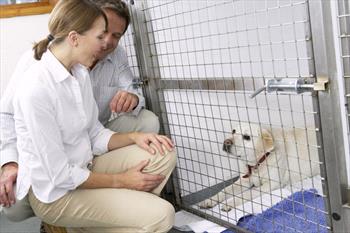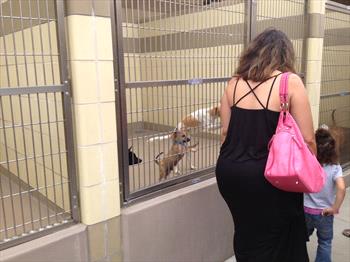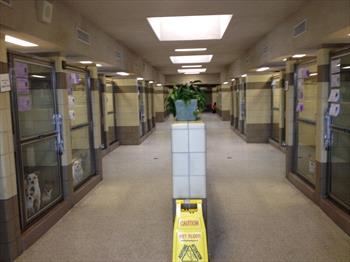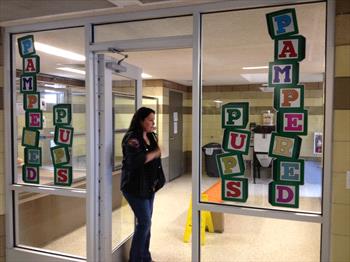During busy seasons some shelters are filled beyond capacity and the best way to remedy this is to get pets adopted out quickly. Besides ensuring that pets are healthy and the environment low stress so that the animals will be comfortable and engaged, what else can shelters do to get these pets adopted out quickly? The following are six marketing tips for increasing adoption rates.
Tip 1: Consider having fewer animals up for adoption. It turns out that having the maximum number of pets up for adoption is not always the best strategy. Just as too many choices at a department store can actually prevent a purchase from being made, too many animals to choose from can be overwhelming. If you have a variety of animals but fewer up for adoption at a time, your overall adoption numbers may increase. A case in point is that of the Kent County Animal Shelter in Kent County, Michigan. Although this shelter has a total annual intake of 4000 cats, in 2011, they decided to only house cats in eye level cages. They had experienced that cats housed at eye level habituate to the shelter more quickly and then become more active and engaged. This, along with other changes designed to decrease stress in the shelter setting lead to a clear increase in adoptions. Nearly 3 times more cats were adopted out during a 3 month period in 2012 compared to that same 3 month time period during 2011, and the number of days that cats were housed prior to adoption dropped from 45 days to 27 in a similar time period.
Tip 2: House animals in a manner that provides easy viewing. At the Riverside County Department of Animal Services (RCDAS) in Riverside, California, cats are housed in multilevel cages that are easily viewable. Visitors can choose to stand or to sit on couches while observing the cats.
Puppies and some small dogs are housed in elevated runs so that visitors can easily see and interact with them.
Note that in both of these cases animals have a choice to avoid being viewed. Cats can go into the litterbox compartment of their cage. Dogs can move to the other side of the divided run.
Tip 3: Find ways to highlight a handful of animals at a time. The RCDAS sometimes has to house up to 1000 dogs per day. With this in mind, their “kennels are staggered so some pop out and some are recessed,” says Kim McWhorter, Shelter Program Chief for RCDAS. “So you are seeing only three at a time instead of 50 kennels per row and 100 dogs. So you see smaller blocks of kennels. From a marketing perspective, when you’re bombarded with too many choices at once, it’s harder to make a decision. When staggering, you only see a few at a time so it’s easier to process it and make a decision on which dog they would like to adopt.
Additionally, the bark wall, which is the wall down the center of the isle that blocks dogs from seeing dogs in other kennels, serves a second useful purpose. It causes the visitors to focus on dogs that are on one side at a time.
Tip 4: House less adoptable animals in locations that increase their visibility. Typically visitors prefer puppies and kittens over adult dogs and cats and also prefer breeds that are not over-represented. RCDAS places their puppies in the puppy room which is way at the end of the dog adoption building. As a result, visitors have to walk past all of the dogs before they have the chance to view the puppies.
Another strategy at RCDAS is to house more common breeds, such as Chihuahuas, with those that are more likely to get viewed. Says Jaclyn Schart, Adoption Supervisor and Behaviorist at RCDAS, “The public will stop to view the adorable white poodle that is housed with a tan Chihuahua. By housing them together, it gets the Chihuahua some attention.” They also have the option to showcase dogs and cats more prominently in lobby life rooms.
Tips 5: Groom dogs to make them more appealing. Grooming dogs can make them more appealing as can placing bandannas or sweaters. The accessories can particularly make a difference with darkly colored dogs. Says Schart, “Bright colors draw the public’s eye.”
Tip 6: Making viewing areas comfortable so that adopters can relax. States McWhorter from RCDAS, “Our building for adoptable cats is called Wond-purr land and it was designed carefully. We wanted to promote cats for adoption so we created an inviting environment where people could come out and see the cats. They are set up behind Plexiglas so people can’t spread contamination. And it’s attractive.”
In addition to these tips, which, once set up, take very little time to implement, there are many other types of procedures that can improve adoptions rate. These include adoption counseling to help match prospective adopters with appropriate pets, as well as adoption promotions. For instance, The Humane Society of Missouri (HSMO) is currently partnering with the Missouri Lottery for a Holiday promotion where people who adopt a pet receive 10 free scratcher tickets for the Missouri Lottery. They also have a promo for cats that is a play on words called “Downton Tabby.” Many shelters also have mobile adoption events and have weekly segments with the local television station featuring a pet of the week.
Overall the strategies to increase adoptions are similar to marketing strategies used in other markets. In a time when pets are overcrowding shelters, thinking outside of the box and implementing these six tips is essential for improving adoption rates and getting animals adopted more quickly.










